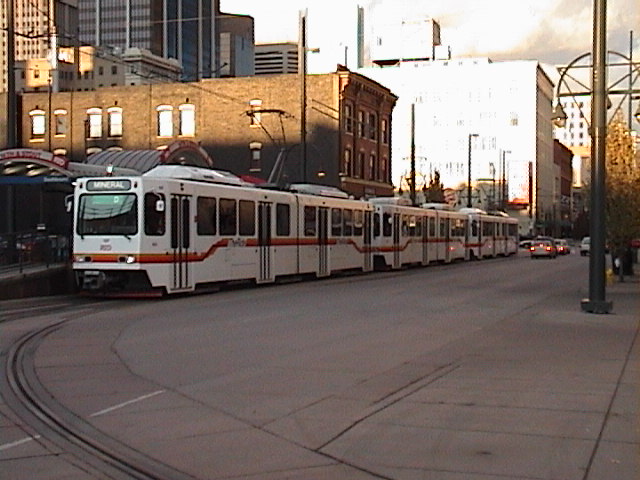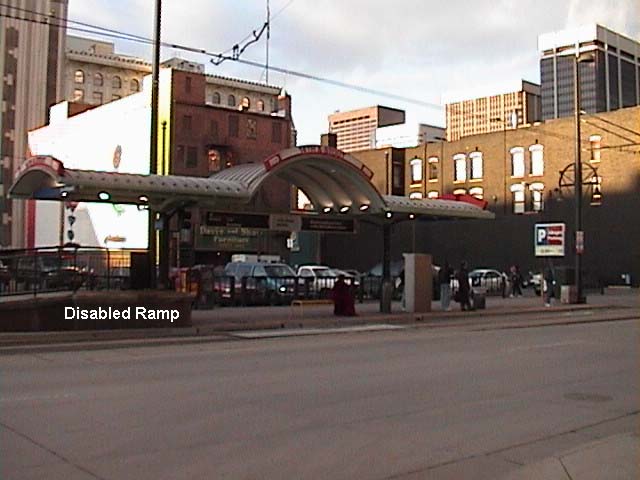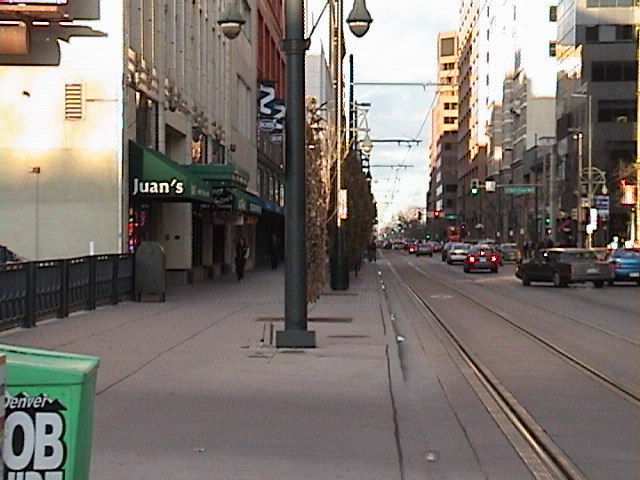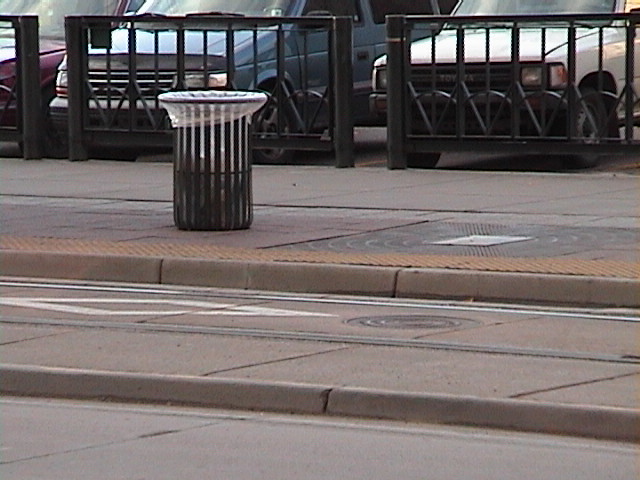
In November of 2002 I was in Denver Colorado where I spent a week there to attend a remote sensing conference. Not only is Denver a VERY clean city with NO litter or graffiti in the downtown area, they also have a very efficient transit system that runs busses and LRTs on a very high frequency of service.
Note: The Denver transit web page is at Denver Transit
Denver has chosen to promote public transit and pedestrian use of the down town core over automotive use. On the 16th Street Mall Denver has a selected to ban cars and instead offers a FREE bus service that runs from Union Station to the State capital building. This street is quite similar to Sparks Street except that the mall section is much longer. They use special hybrid busses that run on electricity and alternative fuels. There are also two bus stations on the mall that allows connections to the regular paid Denver busses. These stations have heated underground bays where people can get on or off the busses.
For bicycle riders a person can use the LRT with a special pass and there are also racks on the front of busses for travel across town. There are also many bike lockers placed at strategic locations throughout the city. A person can purchase a lock for a bike locker for $20.00 per year. The bike lockers look like small garden sheds and they operate on a first come first serve basis. This keeps a person's bike clean, dry and secure. What a great idea...
The link for bikes and bike lockers in Denver is at Denver Transit bike lockers.
The Free mall busses are low floor vehicles and the driver sits on the right side so that s/he has a better view of the passenger side of the bus. The frequency of free bus service is amazing! They basically run every two minutes! Sometimes the wait is even less. The mall itself has many stores, restaurants, bars and theatres making walking no problem if one chooses not to use the free mall shuttle.
Regular paid busses also run on a schedule that is about 10 minutes service.
Here is a picture of a modern Denver LRT:

Denver has developed an LRT service that uses a rail corridor that runs in a north-south direction. They will eventually expand to east-west in the future. The section outside of the downtown core runs on double tracks and it is an electric powered system. Each train is an articulated car and they can run trains with two or three of these articulated cars joined together. To accommodate disabled and people with baby strollers every station has a ramp that allows these people to gain better access to the LRT. For these people, the driver lowers a special small ramp by his door that connects to the ramp.
This picture shows a typical denver LRT station. The ramp is on the left side of the station:

The cars themselves are double enders with seats that face each other (and the kids place their feet on the opposite seats just like on the O-Train! - My only negative comment-) The cars have an accordion style system to connect the car to the overhead power line. The ride is very comfortable and fast. The southern line goes way out to the suburbs, which reminds me of Kanata with the big box malls.
In the downtown area the train splits to two lines:
This picture shows the R.O.W. on a Denver street:

The concrete ROW is raised about 4 inches from the road way to its side. The following picture shows the curb of the LRT R.O.W.:

There are also LRT only boxes painted on the ROW as well as on signs over the LRT lane (as in the Ottawa bus lanes). Consequently cars do not drive in the LRT lanes. The trolley poles are located on the widened sidewalks and planters and other devices are installed along the edge to separate pedestrian traffic from the LRTs. There are LRT stations in the downtown area that operate the same way as in the suburban line. Each station has a machine that sells tickets and like the O-Train it is an honour system where the user has to show the ticket if an inspector comes along. Outside the downtown core the green line goes to the north end of the city. The LRTs are clear, efficient and they are heavily used. The frequency of service like the busses is amazing as well.
The Denver LRT link is at Denver LRT Link.
For Ottawa we could utilize a similar system to Denver.
There is no need to build tunnels or overhead structures.
For example we could modify our bus lanes on Albert and Slater Street to run LRTs with raised concrete lanes. We could then widen the curb sidewalk to eliminate the curb lane and then as in Denver, install LRT stations and trolley poles on the widened sidewalk.

While this is a picture of Denver, It could be a possible route down an downtown Ottawa street such as Slater or Albert.
Once outside the downtown core the Ottawa LRTs could then run east-west on the transit way. Since the War museum will be giving up its use of Vimy house when it moves into its new location that building could be used as a barn to house the LRTs. Vimy house is close to the transit way, it is the middle of its route and it was originally a streetcar barn and may have still have its service bays under its floor.
The present O-train should then run across the river to give access to the Quebec side with a major transfer point at Lebreton flats. Sparks street could also be made into a bus/trolley mall and that would help to attract and people to that part of downtown.
Much of the rush hour busses can also be moved out of downtown to LRT transit stations in the east and west where people can transfer to them. This would mean a shorter run for the busses since they do not have to travel from the downtown core. Since the busses run on shorter routes they can return to the LRT stations in a shorter time to pick up more people. This would create a quicker frequency of service and perhaps also produce less wear and tear on the busses (which is a big and growing problem). The solution to cross-town and downtown rapid transit is right in front of us.
Michael Kostiuk, MA Geography